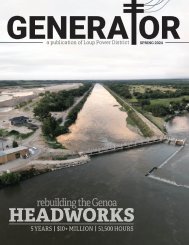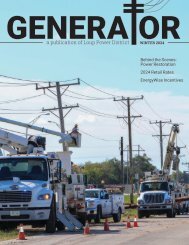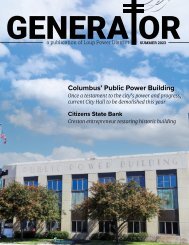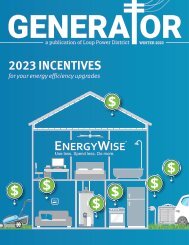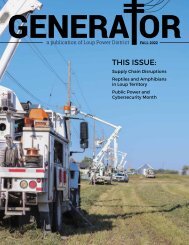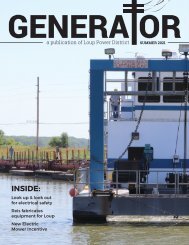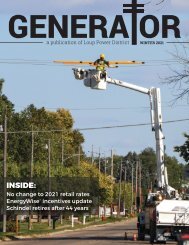Create successful ePaper yourself
Turn your PDF publications into a flip-book with our unique Google optimized e-Paper software.
GENERA OR<br />
a publication of Loup Power District SPRING <strong>2023</strong><br />
LOUP + NPPD + SPP<br />
Working together to bring<br />
reliable & affordable power<br />
to our customers
BOARD OF DIRECTORS<br />
Steve Heesacker<br />
Chairman<br />
Bob Cerv<br />
First Vice Chairman<br />
Jim Donoghue<br />
Second Vice Chairman<br />
Mike Fleming<br />
Secretary<br />
Dick Tooley<br />
Treasurer<br />
Rich Aerni<br />
Alan Drozd<br />
Chris Langemeier<br />
Larry Zach<br />
EXECUTIVE STAFF<br />
Neal Suess<br />
President/CEO<br />
Walt Williams<br />
Vice President,<br />
Accounting & Finance/CFO<br />
Todd Duren<br />
Vice President,<br />
Corporate Services<br />
Korey Hobza<br />
Vice President, Engineering<br />
Dan Hellbusch<br />
Vice President, Operations<br />
The Loup <strong>Generator</strong> is<br />
published quarterly<br />
as a service for Loup<br />
employees, families,<br />
friends, and associates.<br />
For feedback, story ideas<br />
and submissions, contact:<br />
Stacy Wemhoff<br />
Communications Coordinator<br />
402-562-5711<br />
swemhoff@loup.com<br />
Counties receive $2.1 million<br />
Loup Power District recently delivered its<br />
inside revenue payments and the second<br />
half of the in-lieu-of-tax payments to the<br />
counties it serves. This is a benefit of being<br />
served by a locally controlled, not-forprofit<br />
utility.<br />
Like other businesses, Loup Power District<br />
pays sales tax, gasoline taxes, motor<br />
vehicle license fees, and permit fees. The<br />
in-lieu-of-tax payments are made to<br />
service area counties in lieu of occupation,<br />
personal property, and real estate taxes.<br />
County treasurers will distribute the<br />
funds to the various taxing bodies in each<br />
county.<br />
Total in-lieu-of-tax payments for 2022:<br />
Platte — $ 9,713.77<br />
Boone — $5,078.34<br />
Loup pays communities $1.3 million<br />
Loup Power District recently<br />
delivered lease payment<br />
checks totaling more<br />
than $1.3 million to area<br />
communities.<br />
Each of these communities<br />
owns their electric<br />
distribution systems.<br />
These payments<br />
compensate them for the<br />
use of those systems for the<br />
fourth quarter of 2022.<br />
Loup Power District renewed its<br />
membership in Community Clubs<br />
and Chambers of Commerce in towns<br />
throughout its service area.<br />
Checks totaling $31,462 were presented<br />
to communities in Boone, Colfax, Nance,<br />
Platte, and Madison counties. Payment<br />
amounts are based on the 2022 gross<br />
revenues in each community.<br />
“Membership renewal demonstrates<br />
Loup Power District’s commitment to<br />
community involvement in all of our area<br />
towns,” said Todd Duren, Vice President of<br />
Corporate Services for Loup Power District.<br />
Nance — $ 6,445.84<br />
Colfax — $240.48<br />
Madison — $359.27<br />
Total — $ 21,837.70<br />
Communities use the funds<br />
for a variety of public<br />
projects.<br />
The payments were:<br />
Columbus—$985,653.03<br />
Platte Center—$8,916.75<br />
Monroe—$12,242.23<br />
Tarnov—$1,249.05<br />
Creston—$5,082.66<br />
Humphrey—$23,554.52<br />
Lindsay—$51,123.29<br />
Cornlea—$1,626.79<br />
Newman Grove—$17,302.55<br />
The District is also required to make<br />
additional payments to the counties to<br />
guarantee they receive 5 percent of the<br />
inside revenues from the various towns in<br />
their areas subject to the in-lieu-of-tax<br />
payments.<br />
Additional payments to the counties for<br />
2022:<br />
Madison — $35,417.07<br />
Platte — $1,641,628.92<br />
Nance — $123,549.88<br />
Colfax — $108,337.06<br />
Boone — $185,799.17<br />
Total — $2,094,732.10<br />
Duncan —$15,800.89<br />
Fullerton—$29,582.02<br />
Genoa—$21,471.24<br />
Belgrade—$3,257.44<br />
Richland—$2,699.98<br />
Howells—$17,546.50<br />
Leigh—$15,013.18<br />
Clarkson—$16,654.46<br />
Albion—$43,240.94<br />
Cedar Rapids—$19,478.51<br />
Primrose—$1,441.62<br />
Petersburg—$9,781.35<br />
St. Edward—$18,390.12<br />
Total — $1,321,109.12<br />
Loup renews community memberships<br />
Towns and their payments include:<br />
Columbus Area Chamber —$22,309<br />
Albion Chamber of Commerce—$1,583<br />
Lindsay Community Club—$1,403<br />
Fullerton Chamber of Commerce—$1,104<br />
Genoa Chamber of Commerce—$744<br />
Humphrey Community Club—$727<br />
Howells Community Club—$593<br />
Clarkson Community Club—$584<br />
Newman Grove Community Club—$550<br />
St. Edward Community Club—$556<br />
Cedar Rapids Community Club—$496<br />
Petersburg Community Club—$288<br />
Leigh Community Club—$425<br />
Primrose Community Club—$100<br />
2 | GENERATOR
pReSIDeNT’S MessAGe<br />
District finishes $1.5M above<br />
hydro generation forecast<br />
Many people know the District owns two<br />
hydroelectric power plants that generate<br />
electricity — one near Monroe and one near<br />
Columbus. What many people do not know is<br />
that the District sells the power from these<br />
facilities to NPPD, and NPPD includes this<br />
generation as part of their portfolio to provide<br />
power and energy to its customers.<br />
This process has changed quite a bit over the<br />
years. When the District first entered into a<br />
contract to sell this power to NPPD back in the<br />
early 1970s, the payment the District received<br />
was a specific dollar amount each year that<br />
increased with inflation. There was no requirement<br />
regarding how much power was generated<br />
and sold to NPPD, and the District received<br />
this dollar amount no matter how much<br />
energy was generated.<br />
That changed in 2007, when the District<br />
started getting paid for each kilowatt-hour of<br />
energy that was generated and sold to NPPD.<br />
This was based upon a formula tied to the<br />
average cost of all of NPPD’s generating facilities.<br />
Loup did well under this concept, as the<br />
District hydro operators were able to gener-<br />
ate significant amounts of power during these<br />
years (mostly due to upgrades performed at<br />
the hydroelectric generating plants).<br />
Another change was implemented in 2022.<br />
Under a new contract, the District still sells<br />
power to NPPD, but the pricing is based on the<br />
market price for power as determined by the<br />
Southwest Power Pool (SPP). See page 11 for<br />
more detail about how the SPP works.<br />
Although District personnel knew about the<br />
SPP and the SPP markets, selling power based<br />
upon the SPP market price was a new concept<br />
to everyone. I am happy to say that overall<br />
2022 was a very good year for revenue received<br />
from the hydroelectric facilities. The District<br />
finished well above budget (by almost $1.5<br />
million) in revenue received for the generation<br />
from the hydroelectric facilities.<br />
The District’s hydroelectric operators, Headworks<br />
crew, and power canal crew did a great<br />
job in 2022 making sure to maximize the<br />
generation available —overall the District<br />
had almost 20 percent less generation in 2022<br />
compared to 2021.<br />
Using data from NPPD and obtaining knowledge<br />
about the SPP markets, the hydroelectric<br />
operators were able to maximize the generation<br />
at times of peak power pricing and<br />
substantially beat the forecasted revenue<br />
projection — even with less water available to<br />
generate power.<br />
A tip of the hat goes out to all of the hydro-<br />
electric crews for a job well done in 2022. This<br />
was a significant change, and a lot of new ideas<br />
were thrown their way in a short amount of<br />
time.<br />
As the District learns more and more about<br />
the SPP markets, we will continue to grow our<br />
knowledge of how to best maximize the profitability<br />
of the hydroelectric facilities.<br />
NEAL SUESS<br />
President/CEO<br />
SPRING <strong>2023</strong> | 3
RETIREE PROFILE:<br />
STAN<br />
WIELGUS<br />
Loup retiree Stan Wielgus (center) prepares<br />
to set a pole with coworkers in 2016.<br />
Stan Wielgus may have more free<br />
time as a retiree. But he sure doesn’t<br />
spend it sitting around.<br />
In fact, he probably burns more<br />
calories now, figuring in the onemile<br />
swims, 3-mile walks, weight<br />
lifting, and stretching he does on a<br />
regular basis.<br />
“When I retired, that was one<br />
thing I told myself — that I was going<br />
to keep myself healthy,” Wielgus<br />
said. “So I make sure I do that.”<br />
***<br />
Wielgus has always been on the<br />
move in more ways than one.<br />
He joined the Navy right out of<br />
high school, following in the footsteps<br />
of his brother and father. As one<br />
of 10 children, he also knew it was his<br />
key to a better life.<br />
“They were offering an education<br />
and I took advantage of that,”<br />
Wielgus said.<br />
He spent four years seeing the<br />
world — Australia, Japan, China,<br />
Guam, Taiwan, and Hawaii — before<br />
leaving active service. (He later<br />
re-enlisted and spent 14 years in the<br />
Navy Reserve.)<br />
After leaving the Navy, Wielgus<br />
headed to Platte College, followed by<br />
a job at Cornhusker Public Power District.<br />
He joined Loup Power District in<br />
1980 and stayed for nearly 40 years,<br />
working as a Journey Line Technician<br />
and Crew Lead.<br />
“It was definitely right<br />
up my alley because I<br />
like to be outside and I<br />
like to be on the move.”<br />
Wielgus also really enjoyed the<br />
satisfaction of a job well done, like<br />
putting in secondary underground<br />
service<br />
“The ground’s been untouched<br />
and by the time you leave, you have it<br />
trenched and the wire’s in and energized,”<br />
he said.<br />
On the flip side, Wielgus said he<br />
sure doesn’t miss getting called out<br />
to fix storm damage when it was cold<br />
or rainy.<br />
Wielgus knows he put in his hours<br />
on those storm calls. He put in all his<br />
years and now can enjoy retirement.<br />
Looking back, he said all those<br />
years went fast on the whole, but the<br />
last three gearing up to retirement<br />
seemed to take forever. And that’s<br />
understandable since Wielgus had<br />
been working ever since junior high.<br />
Now he has the time to focus on<br />
helping friends and family with<br />
repairs or home improvement<br />
projects. He has time to travel.<br />
And he definitely has time to<br />
exercise. Sometimes he does cardio.<br />
Sometimes he lifts using the same<br />
weight bench he’s had since he got<br />
out of the Navy.<br />
And he goes outside as often as he<br />
can. Sometimes he’ll wander out to<br />
take a look at the stars.<br />
And then he realizes he better<br />
attend to another promise he made<br />
himself.<br />
“I was going to get myself a<br />
telescope, and I haven’t done it yet.”<br />
Wielgus has four children,<br />
five grandchildren and two<br />
great-grandchildren.<br />
4 | GENERATOR
GHW SETTLING BASIN BANK WORK<br />
The Genoa Headworks crew rebuilt the diversion weir<br />
on March 23–24. They repeat this process every spring.<br />
The wooden flashboards (or planks) top a permanent<br />
concrete weir. These sacrificial flashboards are designed<br />
to fail under heavy ice loads or high water to prevent<br />
damage to the permanent fixed weir. It’s more than<br />
1,000 feet long and has a height of about 6 feet.<br />
ACCIDENT REPAIR<br />
An accident damaged a subtransmission pole on Highway<br />
91 just outside of Creston in February. The 34.5kV breaker<br />
tripped once at the time of the accident — around 2 a.m.<br />
— but power came right back on. Loup employees from<br />
Humphrey, Albion, Newman Grove, and Columbus had the<br />
pole replaced by noon that day without any further service<br />
interruption. Photo by Newman Grove Local Superintendent<br />
Alvin Meyer.<br />
DOLLAR GENERAL PREP<br />
Crews from Genoa and Fullerton added three-phase service<br />
to the site of a future Dollar General south of Genoa.<br />
Pictured above are Journey Line Technician Paul Burbach<br />
and Genoa Local Superintendent Dominic Zoucha.<br />
SPRING <strong>2023</strong> | 5
UNDERSTANDING<br />
HEAT PUMPS<br />
At its core, a heat pump transfers heat by relying<br />
on the principle that energy fl ows from HOT to COLD.<br />
This technology is already in refrigerators, cars, and other appliances.<br />
HEAT PUMPS WORK BY<br />
evaporating, compressing and expanding heat.<br />
AIR SOURCE HEAT PUMP<br />
Air source heat pumps are the most common type<br />
of heat pump. They use an outdoor fan to move air<br />
through coils that evaporate the heat into a refrigerant.<br />
An indoor compressor adds pressure to the refrigerant,<br />
raising its temperature. An expansion valve then<br />
releases the air, cycling hot and cold<br />
air to the right place.<br />
This type includes both mini-split<br />
ductless systems and systems<br />
that connect to ductwork,<br />
like a central air conditioning<br />
system.<br />
Modern, enhanced<br />
compressors and expansion<br />
valves allow for heat<br />
pumps to work even in cold climates.<br />
6 | GENERATOR
$<br />
HOW MUCH<br />
HOW MUCH<br />
ENERGY DO HEAT DO THEY COST?<br />
PUMPS USE?<br />
Since heat pumps donʻt create heat, they<br />
are more energy effi cient than traditional<br />
heating and cooling and can produce two<br />
to four times as much heat energy as they<br />
consume.<br />
Just like any heating or cooling system,<br />
heat pumps are more effi cient in spaces<br />
without air leaks and when properly<br />
installed.<br />
Consumer Reports reported an average<br />
cost of $7,791 for installation or about $1,000<br />
more than the average cost for a gas furnace.<br />
Air source pumps rated for colder climates cost<br />
more. Geothermal heat pumps are typically the<br />
most expensive to install, due to the cost to dig<br />
the pipes.<br />
Starting in <strong>2023</strong>, the Infl ation Reduction Act<br />
authorizes a $2,000 tax credit (and rebates<br />
up to $8,000 for income-qualifi ed households).<br />
GEOTHERMAL/GROUND SOURCE<br />
Although air temperatures above ground change<br />
throughout the day and with the seasons,<br />
temperatures of the earth 10 feet below ground<br />
are consistently between 50°F and 60°F. For<br />
most areas of the United States, this means soil<br />
temperatures are usually warmer than the air in<br />
winter and cooler than the air in summer.<br />
Geothermal heat pumps use the<br />
earth’s constant temperature to<br />
heat and cool buildings. They<br />
transfer heat from the ground<br />
(or water) into buildings during<br />
the winter and reverse the<br />
process in the summer.<br />
SPRING <strong>2023</strong> | 7
A calculated risk.<br />
That might be the best way to<br />
describe what happens inside the<br />
Columbus Powerhouse every day.<br />
Because even though the Plant<br />
Operators are constantly monitoring<br />
the water levels in the canal, the river,<br />
and the lakes, there’s no way to know<br />
for certain what the energy market<br />
and Mother Nature will do.<br />
“We need to generate at peak levels<br />
when the pricing is best,” said Plant<br />
Operator Craig Baxa.<br />
But how exactly do Loup’s Plant<br />
Operators accomplish this task?<br />
At the beginning of each 12-hour<br />
shift, the incoming plant operator<br />
gets a rundown of what happened<br />
overnight or during the day including<br />
8 | GENERATOR<br />
storm reports and power outages.<br />
The operator then checks water<br />
level gauges on several rivers, including<br />
the Middle Loup and North Loup<br />
near St. Paul. He also checks in with<br />
employees at the Genoa Headworks<br />
to see what the river looks like at the<br />
canal intake.<br />
The operators receive a six-day<br />
energy outlook every day. These forecasts<br />
are based on historical demand<br />
as well as factors like temperature,<br />
wind speed, and precipitation.<br />
That forecast estimates the wholesale<br />
market price per megawatt hour<br />
every hour for those six days based on<br />
expected generation and demand.<br />
“Having the information of the<br />
upstream water flows paired with the<br />
information of the day-ahead pricing<br />
forecast allows us to start preparing a<br />
generation plan,” Baxa said.<br />
That pricing forecast updates each<br />
morning for the next six days. This<br />
allows operators time to ensure that<br />
regulating reservoirs Lake North and<br />
Lake Babcock are full so they can<br />
generate at a higher level when prices<br />
are high.<br />
After the operator decides how<br />
much electricity Loup will generate<br />
each hour for the next day, it is<br />
bid into the Southwest Power Pool’s<br />
wholesale energy market.<br />
Nebraska Public Power District,<br />
Loup’s wholesale energy provider,<br />
provides this service out of its<br />
Doniphan Control Center.
A<br />
TEAM<br />
Left: Plant Operator Justin Kohl<br />
at the Columbus Powerhouse.<br />
Above: An aerial view of the<br />
Columbus Powerhouse. Three<br />
penstocks direct water from the<br />
canal down 112 feet to the<br />
turbines. Each penstock is 20<br />
feet in diameter and 300 feet<br />
long.<br />
SPRING <strong>2023</strong> | 9
While the forecast is generally accurate,<br />
the real-time energy market<br />
can still change every minute. Because<br />
prices are so volatile, there are times<br />
where Loup generates electricity into a<br />
negative market and loses money.<br />
Loup must put the promised<br />
amount of electricity onto SPP’s grid.<br />
If conditions change and Loup cannot<br />
meet that promise, we must buy it<br />
back at the real-time price.<br />
Another hurdle to generation planning<br />
is compliance with Loup’s license<br />
from the Federal Energy Regulatory<br />
Commission.<br />
License restrictions state that Loup<br />
must ensure minimum water flows in<br />
the bypass reach (the portion of the<br />
Loup River from the diversion weir to<br />
1<br />
its meeting with the Platte River). The<br />
District is also limited to a maximum<br />
diversion of 2,000 cubic feet per second<br />
from March 1 to June 7.<br />
But the operators’ duties don’t end<br />
there. The Columbus Powerhouse<br />
serves as an after-hours call center.<br />
Operators reconnect customers, take<br />
payments, answer outage calls and dispatch<br />
line technicians to those outages.<br />
They also monitor Loup’s substations<br />
and their security with the Supervisory<br />
Control and Data Acquisition<br />
(SCADA) system.<br />
Loup’s five Powerhouse Operators<br />
—Baxa, Jamie Held, Blane Konwinski,<br />
Justin Kohl, and Tony Miller — handled<br />
all these duties with success last<br />
year.<br />
2<br />
Prior to 2022, Loup sold its energy<br />
generation to NPPD and was paid for<br />
each kilowatt hour based on a formula<br />
tied to the average cost of NPPD’s<br />
generating facilities.<br />
In their first year navigating the<br />
SPP market, the operators beat the<br />
generation revenue forecast by nearly<br />
$1.5 million and did so with less water<br />
than the previous year.<br />
But the operators are quick to point<br />
out that the success is due in large part<br />
to their fellow employees at the Headworks<br />
and those on the canal crew.<br />
Headworks employees operate the<br />
intake gates, diverting as much water<br />
as possible based on river conditions<br />
and license restrictions. They, too,<br />
constantly monitor the water levels<br />
and alert the operators to any changes.<br />
The canal crew employees help<br />
maintain the canal system, ensuring<br />
that everything is working properly.<br />
And together, they made certain<br />
that their calculated risk paid off.<br />
Loup Power District generates electricity<br />
at its powerhouses in Monroe and Columbus.<br />
NPPD — Loup’s wholesale energy provider<br />
— bids the electricity (along with its own) into<br />
SPP’s wholesale energy market, competing<br />
against other generators.<br />
3<br />
5<br />
SPP selects the lowest-cost<br />
resources based on fuel and variable<br />
operation and maintenance costs.<br />
Loup purchases energy<br />
from NPPD to serve customers.<br />
4<br />
10 | GENERATOR<br />
NPPD buys energy back from SPP<br />
to serve customers, including Loup,<br />
at a market price.
What is the<br />
Southwest<br />
Power Pool?<br />
Our lives depend on electricity, but<br />
most of us have no idea how many<br />
people, machines, and complex<br />
processes work together around the<br />
clock, every day of the year to ensure<br />
the reliable supply of cost-effective<br />
power.<br />
The Southwest Power Pool (SPP) is<br />
a major player in this process. Even<br />
so, the organization remained largely<br />
unknown by the public until the February<br />
2021 winter storm that impacted<br />
more than 170 million Americans.<br />
SPP is a regional transmission organization<br />
(RTO) based in Little Rock,<br />
Ark. It manages the bulk electric grid,<br />
operates a wholesale electric market,<br />
and plans transmission on behalf of<br />
utilities and transmission companies.<br />
Like air-traffic controllers — who<br />
don’t own the planes they direct,<br />
the skies they monitor, or the airports<br />
that serve as travel hubs — SPP<br />
doesn’t own power plants or transmission<br />
lines, but instead directs the<br />
regional bulk power grid to ensure<br />
that electricity gets from where it’s<br />
made to where it’s needed.<br />
Back in February 2021, historic cold<br />
temperatures caused massive consumption<br />
of heat and power, straining<br />
the electric grid. To preserve that grid<br />
and prevent catastrophic failures, SPP<br />
implemented rolling blackouts for the<br />
first time in its 80-year history.<br />
Nebraska Public Power District is<br />
Loup’s wholesale power provider and<br />
has been a member of SPP since 2009.<br />
In turn, Loup is a member of SPP.<br />
While customers throughout the state<br />
and Midwest were frustrated by the<br />
blackouts, the event also highlighted<br />
the benefit of SPP membership.<br />
SPP’s members all shared energy<br />
during the crisis, directing it to where<br />
it was needed the most. This helped<br />
minimize impacts to any one entity.<br />
Those short energy curtailments prevented<br />
the grid from cascading out of<br />
control like it did in Texas.<br />
That state suffered a major power<br />
crisis when the winter storm hit. More<br />
than 4.5 million homes and businesses<br />
were without power — some for<br />
several days — because electric utilities<br />
in state failed to winterize power<br />
sources like wind turbines and natural<br />
gas infrastructure.<br />
In addition, Texas’ power grid is not<br />
connected to national grids, so it was<br />
difficult to import excess energy from<br />
other states during the storm.<br />
Nebraska would have potentially been<br />
in the same situation if it maintained<br />
its own power grid, for example.<br />
Although the state generates plenty<br />
of power, we rely on our neighbors for<br />
help when sustained weather events<br />
— extreme heat or cold — spike the<br />
amount of power we consume.<br />
The arrangement also saves utilities<br />
—including NPPD and Loup —<br />
money at the end of the day. Overall,<br />
SPP’s services provided members<br />
$2.7 billion in net benefits in 2021 at a<br />
benefit-to-cost ratio of 18-to-1.<br />
THE SPP REGION<br />
552,885 square mile service territory<br />
More than 18 million people<br />
949 generating plants<br />
5,180 substations<br />
SPRING <strong>2023</strong> | 11
SPP partners with companies in 15 states<br />
SPP is a regional transmission organization (RTO): a<br />
nonprofit corporation mandated by the Federal Energy<br />
Regulatory Commission to ensure reliable supplies of<br />
power, adequate transmission infrastructure, and competitive<br />
wholesale electricity prices on behalf of its members.<br />
SPP helps ensure almost 19 million people across its service<br />
territory have reliable and affordable power.<br />
Southwest Power Pool dates to 1941, when 11 regional<br />
power companies joined to keep an Arkansas aluminum<br />
factory powered around the clock to meet critical defense<br />
needs. After the war, SPP’s Executive Committee decided the<br />
organization should be retained to maintain electric reli-<br />
ability and coordination.<br />
TOP GRID PRIORITIES:<br />
ENSURE adequate generation to maintain reliability under<br />
normal & extreme conditions<br />
PROTECT the grid from cyber attacks<br />
BUILD transmission to connect new generations and<br />
customers to the grid<br />
FACILITATE robust wholesale markets that make low-cost<br />
energy widely available<br />
REDUCE risks and costs associated with extreme events<br />
2021 Annual Spot Map<br />
Source: FERC 2021 State of the Markets Report<br />
In 2021, SPP’s average wholesale<br />
market prices were the lowest of<br />
any organized market in the U.S.<br />
SPP IS LIKE AIR TRAFFIC CONTROL<br />
AIR TRAFFIC CONTROL<br />
SOUTHWEST POWER POOL<br />
Does not own airplanes,<br />
airlines, or airports<br />
Does not own the sky<br />
it monitors<br />
Directs air routes to ensure<br />
airplanes and passengers<br />
are safely transported<br />
Does not own utilities, power<br />
generators, or transmission lines<br />
Does not own the land<br />
electricity flows across<br />
Monitors and directs regional<br />
bulk power grid to ensure electricity<br />
gets from where it’s made<br />
to where it’s needed<br />
12 | GENERATOR
A storm warning means<br />
TAKE ACTION<br />
Stay Safe During and After a Storm<br />
Storms can be unpredictable and wreak havoc on the power grid. Severe wind and<br />
ice accumulation can cause power lines to gallop or snap. Tornadoes and hurricanes<br />
can bring down transmission towers, power poles and power lines and damage other<br />
equipment. Lightning can strike a transformer. All types of severe weather events can<br />
cause damage or make utility equipment difficult to access.<br />
Do all you can to keep yourself and others safe during or after a storm.<br />
KEEP YOU AND YOURS SAFE<br />
• Install a weather app for severe weather notifications.<br />
• Shelter in a safe area. (Storm warning = take action!)<br />
• Have an evacuation plan in place (e.g., for floods, wildfires).<br />
• Make sure your emergency kit is properly stocked and up to date.<br />
• Follow all manufacturer’s instructions when using a generator.<br />
• Place a portable generator at least 20 feet away from doors and windows.<br />
• Use a generator in an open area (not in a garage, carport or enclosed space).<br />
• Ensure carbon monoxide alarms are installed on every level of your home.<br />
KEEP OTHERS SAFE<br />
Do not plug a generator into a wall outlet, which can cause backfeed. Backfeed means<br />
that power can go from your home back into the power grid and endanger crews that<br />
are working to restore power.<br />
DURING CLEANUP<br />
• If there is an outage, do not go outdoors until the power has been restored.<br />
• Ice, snow, standing water or storm debris could be covering downed power lines.<br />
• Never approach a downed power line; call 9-1-1 to report it. Alert others to stay away.<br />
• Do not trim trees/branches within 10 feet of an overhead power line.<br />
Learn more at:<br />
SPRING <strong>2023</strong> | 13
employee notes<br />
SCOTT SNYDER<br />
Headworks Operator<br />
Scott Snyder retired<br />
from Loup Power<br />
District after 30<br />
years of service.<br />
Snyder joined Loup<br />
in 1992 as a Maintenance<br />
Man at the<br />
Genoa Headworks.<br />
He was promoted<br />
to Dredge Operator<br />
in 1998 and was<br />
named Headworks<br />
Operator in 2018.<br />
He was a member of the team that<br />
operates and maintains the District’s<br />
dredge at the Genoa Headworks.<br />
Snyder is a native of Genoa and a<br />
graduate of Genoa High School. He<br />
and his late wife, Rose, are the parents<br />
of a daughter, Tanya, and a grandson,<br />
Easton.<br />
AMANDA HENRY<br />
Human Resources Manager<br />
Amanda Henry<br />
joined Loup Power<br />
District in 2013 as<br />
Human Resources<br />
Manager.<br />
She is responsible<br />
for maintaining the<br />
District’s policies<br />
and procedures<br />
in the human<br />
resources area and<br />
for ensuring compliance<br />
with all federal<br />
and state regulations.<br />
Henry is a graduate of Columbus High<br />
School and earned a bachelor’s degree<br />
in Communication Studies from the<br />
University of Nebraska–Lincoln and<br />
a master’s degree in Management<br />
from Doane College. She holds a PHR<br />
(Professional in Human Resources) certification<br />
and SHRM-CP Certification.<br />
She serves as a board member for<br />
the Columbus Area Human Resource<br />
Association and Society for Human<br />
Resource Management (SHRM) of<br />
Nebraska.<br />
She has a daughter, Elyssa.<br />
RETIRED<br />
10 YEARS<br />
TIM RECEK<br />
Carpenter/Utility<br />
Tim Recek of<br />
Columbus was<br />
recently promoted<br />
to Carpenter/Utility<br />
at Loup Power<br />
District.<br />
In his new role,<br />
Recek is responsible<br />
for the construction<br />
and maintenance<br />
of District facilities,<br />
such as substation<br />
foundations and<br />
buildings, office buildings, and retail<br />
offices. He also helps maintain the<br />
canal and surrounding areas.<br />
Recek joined Loup Power District in<br />
2017 as a Utilityman based out of the<br />
Columbus Service Center. In 2019, he<br />
transferred to Maintenance Man and<br />
was promoted to Equipment Operator<br />
in 2020.<br />
Recek and his wife, Brenda, have two<br />
children: son, Dylan, and daughter,<br />
Sydney.<br />
JOE KLECKNER<br />
Headworks Operator<br />
Kleckner joined<br />
Loup in 2008 as<br />
a Maintenance<br />
Man at the Genoa<br />
Headworks. He<br />
was promoted to<br />
Equipment Operator<br />
in 2011 before being<br />
named Dredge<br />
Operator in 2018. In<br />
2021, he transferred<br />
to Headworks<br />
Operator.<br />
PROMOTION<br />
15 YEARS<br />
Kleckner operates and maintains<br />
heavy equipment at Loup’s Genoa<br />
Headworks. He also builds discharge<br />
pipeline for the dredge, constructs<br />
and maintains dikes in the Headworks<br />
discharge area, and performs other<br />
hydro-related tasks.<br />
Kleckner is a graduate of Genoa High<br />
School. He and his wife, Brooke, are<br />
the parents of two children: Ryder and<br />
Annabelle.<br />
SCOTT GOTTSCH<br />
Storekeeper<br />
Scott Gottsch joined<br />
Loup in 1998 as a<br />
Maintenance Man at<br />
the Genoa Headworks.<br />
In 2000, he<br />
was promoted to<br />
Carpenter/Utilityman<br />
on the Canal Crew<br />
based out of the<br />
Columbus Service<br />
Center.<br />
Gottsch was<br />
promoted to Headgates Operator at<br />
the Genoa Headworks in 2008 and<br />
transferred to the position of Storekeeper<br />
I in 2016.<br />
As Storekeeper, Gottsch’s duties<br />
include purchasing, storing, and issuing<br />
materials and stock for projects across<br />
Loup’s service area. The materials<br />
include poles, connectors, and wire.<br />
Gottsch is a graduate of Monroe High<br />
School. He and his wife, Sandy, are<br />
the parents of three children: Kelly,<br />
Megan and Courtney. They have eight<br />
grandchildren.<br />
JUSTIN M KOHL<br />
Meter Relay and Equipment Technician<br />
Justin Kohl joined<br />
Loup Power District<br />
as Meter Relay and<br />
Equipment Technician<br />
at the Columbus<br />
Service Center<br />
in 2022.<br />
In this role, Kohl is<br />
a member of the<br />
team responsible<br />
for installation and<br />
1 YEAR<br />
maintenance of<br />
substation power<br />
equipment. He is also responsible for<br />
reading meters and completing service<br />
orders.<br />
Kohl is a native of Lincoln and a graduate<br />
of Lincoln East High School. He<br />
has associates degrees in Electrical<br />
Construction and Control from Northeast<br />
Community College and Utility<br />
Line from Metro Community College.<br />
Kohl and his wife, Abbi, have two<br />
children: Ella and Rhett.<br />
25 YEARS<br />
14 | GENERATOR
REY JARECKI<br />
Carpenter/Utility<br />
Carpenter/Utility Rey<br />
Jarecki has retired<br />
after more than 30<br />
years of service to<br />
Loup Power District<br />
Jarecki joined Loup<br />
in 1992 as an Assistant<br />
Plant Operator<br />
at the Columbus<br />
Powerhouse. He<br />
was promoted to<br />
Plant Operator<br />
at the Columbus<br />
Powerhouse in 1993.<br />
In 2012, he transferred to his current<br />
position of Carpenter/Utility on the<br />
Canal Crew based out of the Columbus<br />
Service Center.<br />
Jarecki’s duties included the construction<br />
and maintenance of District facilities,<br />
office buildings, and retail offices.<br />
He also helped maintain the canal.<br />
Jarecki is a graduate of Scotus Central<br />
Catholic High School. He and his wife,<br />
Lori, are the parents of three children:<br />
Ryan, Liz, and Emily. They also have six<br />
grandchildren: Rylie, Maddix, Reece,<br />
Charlotte, Memphis, and Thomas<br />
CINDY GASPER<br />
Customer Service Representative<br />
Cindy Gasper of<br />
Columbus joined<br />
Loup Power District<br />
as a Customer<br />
Service Representative<br />
at the Columbus<br />
General Office in<br />
2018.<br />
RETIRED<br />
Gasper’s responsibilities<br />
include<br />
greeting customers,<br />
processing payments,<br />
setting up<br />
5 YEARS<br />
and closing service orders and water<br />
heater contracts, and answering phone<br />
calls.<br />
Gasper is a graduate of Humphrey St.<br />
Francis and attended Wayne State College.<br />
She and her husband, Greg, have<br />
four children: Levi, Lindsey, Mikayla,<br />
and Michael. They also have a granddaughter,<br />
Olivia.<br />
JAMIE HELD<br />
Plant Operator<br />
Jamie Held joined<br />
Loup in 1998 as a<br />
Maintenance Man<br />
on the Canal Crew<br />
based out of the<br />
Columbus Service<br />
Center.<br />
In 2003, he was<br />
promoted to Equipment<br />
Operator and<br />
was promoted to<br />
25 YEARS<br />
Carpenter/Utilityman<br />
in 2008. Held<br />
was promoted to Monroe Powerhouse<br />
Chief Operator in 2012 and transferred<br />
to Plant Operator in 2020.<br />
As a plant operator, Held monitors and<br />
controls the three generation units at<br />
Columbus and remotely controls the<br />
Monroe Powerhouse. He also works<br />
closely with the Genoa Headworks to<br />
divert maximum Loup River water into<br />
the District canal system for power<br />
generation.<br />
Held is a graduate of Columbus High<br />
School and attended Central Community<br />
College in Columbus.<br />
He and his wife, Jamie, are the parents<br />
of six children: Natalie, Nathan, Chloe,<br />
Libby, Zachary, and Callie.<br />
JOHN FRITZGES<br />
Dredge Operator<br />
John Fritzges of St.<br />
Edward joined Loup<br />
in 2018 as Maintenance<br />
Man at the<br />
Genoa Headworks.<br />
He was promoted to<br />
Dredge Operator in<br />
2022.<br />
Fritzges is part of a<br />
team that operates<br />
and maintains the<br />
District’s dredge<br />
at the Genoa<br />
Headworks.<br />
5 YEARS<br />
He and his wife, Kaitlin, have five<br />
children: Kohen, Reese, Rhett, Cecelia,<br />
and Ty.<br />
CHUCK McCUMBER<br />
Engineering Supervisor<br />
Chuck McCumber,<br />
P.E., retired after<br />
more than 15 years<br />
of service.<br />
McCumber joined<br />
Loup in 2007 as<br />
Engineering Supervisor.<br />
His duties<br />
included system<br />
design of lines and<br />
substations. He<br />
RETIRED<br />
also evaluated and<br />
purchased equipment<br />
and systems in conjunction with<br />
Loup’s load management and SCADA<br />
(Supervisory Control and Data Acquisition)<br />
programs.<br />
McCumber has an Associate of Applied<br />
Science degree in Engineering from<br />
Northwest Wyoming Community College,<br />
a bachelor’s degree in Electrical<br />
Engineering from the University of<br />
Wyoming, and a master’s degree in<br />
Engineering Management from the<br />
University of Kansas. He earned his<br />
Professional Engineering license in<br />
2009.<br />
McCumber and his wife, Sandy, are the<br />
parents of two children: Jake and Emily.<br />
They have two grandchildren.<br />
TYLER HINER<br />
Equipment Operator<br />
Tyler Hiner of<br />
Columbus has<br />
joined Loup Power<br />
District as an Equipment<br />
Operator at the<br />
Columbus Service<br />
Center.<br />
Hiner operates the<br />
District’s heavy<br />
equipment and is<br />
part of the crew that<br />
WELCOME<br />
performs maintenance<br />
on the canal<br />
system from Genoa to Columbus. He<br />
also works at the two powerhouses<br />
when needed, helps build substations,<br />
and maintains District parks and lakes.<br />
Hiner is a graduate of Howells High<br />
School and Wayne State College. He<br />
and his wife, Megan, have a daughter,<br />
Addilynn.<br />
SPRING <strong>2023</strong> | 15
2404 15th Street | PO Box 988<br />
Columbus, NE 68602-0988<br />
Geese at Lake Babcock<br />
on March 13.



